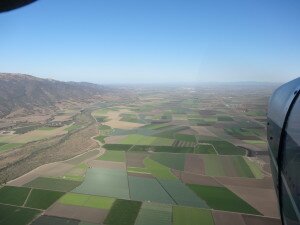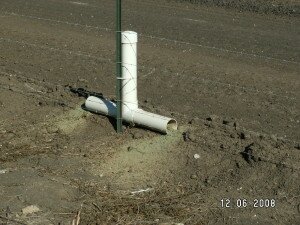agricultural pollution

Photo by Steve Shimek
Skip to the bottom of this page for important Action in June 2018.
Rich agricultural areas such as the Pajaro, Salinas, and Santa Maria river valleys are intensively farmed. It has been said that 80% of all the leafy greens and strawberries found in our supermarkets nation-wide come from right here on the Central Coast region. Having such a large amount of land devoted to agriculture has an immense impact on not only our land but our waterways and ocean.
Nutrient runoff causes ocean “dead zones” and harmful algal blooms. In 2010 scientists discovered that otters were dying of microcystis poisoning. Microcystis is a highly toxic freshwater algae that flows into the ocean and is concentrated by the shellfish otters eat. Since 2010 there have been at least three dozen sea otter deaths from microcystis poisoning.
Pesticides and other agricultural chemicals can build up and impact the otter’s immune system. The Central Coast has the highest percentage of “highly toxic” surface waters in the State of California; fifty-five percent of Central Coast water kills the test organisms put into water samples. Our water should not kill the organisms that live in it! The toxic waters fouling the otters home impacts the food supply and the otters themselves.

The inland valleys of California’s central coast are intensively farmed for 9 to 10 months of the year. The Otter Project monitors the Salinas Valley by small plane. One grower threatened to shoot the plane down. The Salinas River is to the left and Monterey Bay in the far distance.
The Otter Project believes that agriculture has every right to use our water; but agriculture does not have the right to return (discharge) the water toxic to otters, humans and the environment.
But it is not just about the otters; we live in the same fouled environment. It’s all connected.
Solutions are difficult and politically charged (Click here to read The Otter Project article in the Waterkeeper Alliance Magazine)
Growers apply fertilizers to help their crops grow and pesticides to kill harmful bugs and weeds. The problem comes when these chemicals wash from the crops and fields and into our groundwater, waterways, and ocean where the chemicals are wasted for the farmer and harmful to people and wildlife. And it happens all the time. In some areas of the Salinas Valley (the heart of the sea otter’s range) more than 50% of wells are too polluted to drink from and the waterways are fouled and toxic.
All growers (including those that grow organically) must fertilize and kill harmful bugs. The question is, how to do it just exactly right; the consequences for under-fertilizing can bankrupt. Growers should be able to apply the amount the crop needs, plus a little extra for insurance. This all means that agriculture should be incentivized and regulated to apply the right amount of chemicals and still, agricultural waste water will need to be treated before being discharged.
In the US, irrigated agriculture is essentially exempt from America’s Clean Water Act. Some states have rules stricter than federal, and in California, agriculture in not exempt; but for decades, a lack of political will has put agriculture out of reach of regulation.

Thousands of rodent bait stations have been installed along the edge of most farm fields in the Salinas Valley. Bait can gush out and wash into ditches and streams. Bait is an anticoagulant poison that has been found to move up the food chain to kill birds of prey and endangered kit foxes.
In 2008 The Otter Project decided it was imperative to deal with the toxic brew of chemicals washing from wasteful farms. In early 2014 The Otter Project, together with Pacific Coast Federation of Fishermen Associations ( all the pacific coast commercial fishermen), California sport fishermen (California Sportfishing Protection Alliance), the Environmental Justice Coalition for Water, Santa Barbara Channelkeeper, and a low income individual impacted by poor water quality sued the State of California for failing to regulate agricultural pollution. (click here to see our lawsuit against the State of California).
In 2010, The Otter Project sued Monterey County Water Resources Agency. Monterey County Water Resources Agency maintains a countywide system of ditches and pumps that collect agriculture waste water and then discharges that water — untreated — directly into the Salinas River (and then into the ocean) and Elkhorn Slough where over a hundred otters call home. The Otter Project claimed the Monterey County Water Resources Agency has a responsibility to protect water quality and is responsible for clean the water to a high standard before discharge. The Otter Project WON its lawsuit against Monterey County Water Resources Agency in March 2015. (Click here to see our lawsuit against Monterey County Water Resources Agency).
Since 2008 when The Otter Project became heavily involved in agriculture, agriculture has fought back. Otters have been consistently winning in court, but Corporate Ag has tried to undo the wins by passing legislation. First, in 2010, Western Growers Association (an association of all the vegetable growers), lobbied the Governor’s Office to entirely abolish the Central Coast Water Board, the agency that, at the time, was trying to pass the most progressive regulation in the State. We pushed Corporate Ag’s effort back. Then Big Ag tried to pass legislation exempting ag from water quality laws. We fought that back. Then they tried again, and we fought that back again. But now in June 2018, we are faced with possibly the most difficult and thought provoking challenge yet: Ag has offered to contribute money to a state-held fund to provide clean drinking water to disadvantaged communities in exchange for immunity from pollution laws. We call it, pay-to-pollute. And ag wants to pays only pennies on the dollar of actual cost. In perhaps our most difficult decision in 20 years, The Otter Project is opposing California’s Safe and Affordable Drinking Water Fund legislation, unless the pay-to-pollute provision is removed. Governor Brown is supporting Corporate Ag and has included the fund in his budget bill.
Click here for a copy of the proposed legislation.
Click here to see Stanford Environmental Law Clinic’s Analysis of the legislation.
 Our water quality program is affiliated with the international Waterkeeper Alliance and is separately branded as Monterey Coastkeeper. Waterkeepers around the world are dedicated to protecting and restoring clean — drinkable, swimmable, and fishable — waters. The Alliance is led by Bobby Kennedy Jr.
Our water quality program is affiliated with the international Waterkeeper Alliance and is separately branded as Monterey Coastkeeper. Waterkeepers around the world are dedicated to protecting and restoring clean — drinkable, swimmable, and fishable — waters. The Alliance is led by Bobby Kennedy Jr.
Facebook Wordpress Twitteryoutubemeet